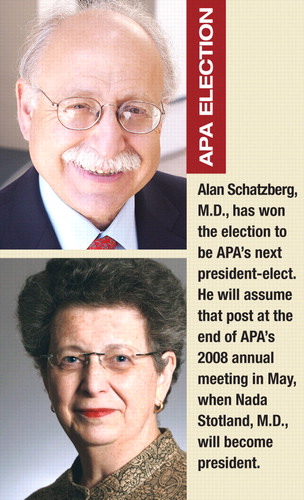Schatzberg Wins APA Presidency
APA members have decided to hand the reins of the Association to Stanford University psychiatrist Alan Schatzberg, M.D.

Schatzberg, a renowned researcher, president of the Board of Directors of American Psychiatric Publishing Inc., and a newcomer to APA politics, bested APA secretary-treasurer Donna Norris, M.D, in the contest to become the next president-elect. Schatzberg won 59.6 percent of the votes in the 2008 election.
Schatzberg has been chair of the Department of Psychiatry at Stanford University since 1991 and is familiar to thousands of psychiatrists as coauthor of the Textbook of Psychopharmacology, a staple of many residency programs.
In the race for secretary-treasurer, Vermont psychiatrist David Fassler, M.D., outpolled Burton Reifler, M.D., of North Carolina, winning 59.3 percent of the vote. Fassler is completing his second three-year term as a trustee-at-large.
Three candidates were vying to become a trustee-at-large. Dilip Jeste, M.D., a schizophrenia and geriatric psychiatry researcher in San Diego, emerged the victor, garnering 51.5 percent of the vote after APA's“ preferential voting system” was used. His opponents were Francis Lu, M.D., of San Francisco and Ann Marie Sullivan, M.D., of New York.
Under the preferential voting system, which is used in races with more than one candidate, voters are asked to rank the candidates in the order in which they would like to see them win. If no candidate garners a majority in the first round of counting, the candidate with the lowest number of votes is eliminated—in this case that was Lu—and the second-choice votes on the ballots cast for him or her are distributed to the remaining candidates. Jeste received a majority after the redistributed votes were apportioned between him and Sullivan.
With a trio of candidates competing, the preferential voting mechanism was also used to determine who the next member-in-training trustee-elect (MITTE) would be.
The winner was Melinda Fierros, M.D., a PGY-3 resident at Wright State University in Ohio and a member of the U.S. Air Force. She outpolled Christain Neal, M.D., a resident at Palmetto Health Alliance/University of South Carolina, and Scott Shaffer, M.D., a resident at Brown University.
Fierros received 57.3 percent of the votes in the second round of counting after the votes for Shaffer, who came in third, were redistributed.
Two APA Areas also had trustee elections this year. In Area 2, which includes all of the New York state district branches, former Assembly Speaker James Nininger, M.D., bested Seeth Vivek, M.D.
In Area 5, encompassing the South as well as Puerto Rico and the district branch for psychiatrists in the military, Kentucky psychiatrist Mary Helen Davis, M.D., was elected to a second term. She defeated Harold Ginzburg, M.D., of Louisiana.
Newly elected officers and trustees will take office at the close of APA's 2008 annual meeting in Washington, D.C. Also at that time President-elect Nada Stotland, M.D., will become president, and the MITTE, Lauren Sitzer, M.D., will become member-in-training trustee. (Unlike the member-in-training trustee, the MITTE does not have a vote on the Board.)
A total of 10,053 members voted in the 2008 election. This represents 31.2 percent of eligible voters, up from 29 percent last year.
About one-third of APA members opted to submit their ballots online this year, about the same number as in the 2007



